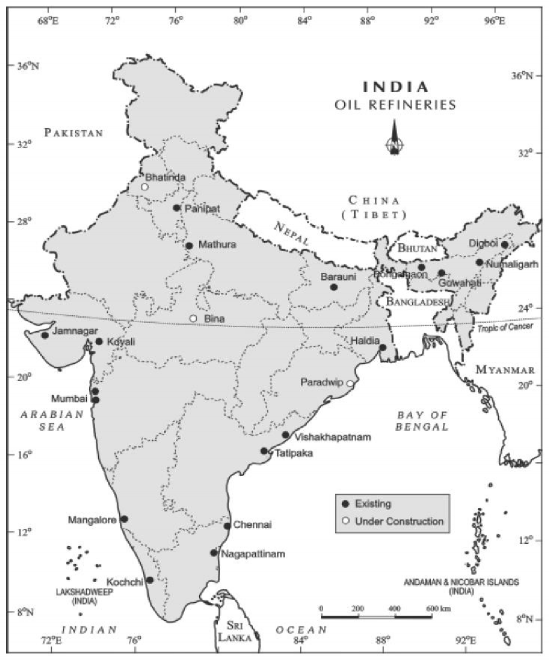2.1.2. Petroleum
Crude petroleum consists of hydrocarbons of liquid and gaseous states varying in chemical composition, colour and specific gravity. It is an essential source of energy for all internal combustion engines in automobiles, railways and aircraft. Its numerous by-products are processed in petrochemical industries such as fertiliser, synthetic rubber, synthetic fibre, medicines, Vaseline, lubricants, wax, soap and cosmetics.
The crude petroleum deposits are found only in the sedimentary rock basins of marine origin. But all sedimentary rocks do not contain mineral oil. Petroleum has an organic origin and is formed by the gradual decay and compression of various marine deposits. They remain buried for millions of years and the decomposition of the organic matter has led to the formation of mineral oil. According to latest estimates the total reserves of crude oil are about 500 crore tons on land and in off-shore regions. There are three main areas of potential petroleum reserves. These are:
1. The Terai zone running parallel to the Himalayas from Jammu and Kashmir to Assam;
2. River basins of Ganga, Satluj, etc. including deltaic tracts of Ganga, Mahanadi, Godavari, Krishna and Kaveri;
3. The continental shelf along the Western Coast, Gulf of Cambay, and the islands in the Arabian Sea and the Bay of Bengal. Oil and natural gas have been recently found in exploratory wells in Krishna-Godavari and Kaveri basin on the east coast.
India is not self-sufficient in respect of crude oil and has to import huge quantities from abroad. At present, India has to import about 55 per cent of its needs of petroleum and its products. The imports are mainly from the Middle East countries (Iraq, Iran, Kuwait, Saudi Arabia, Bahrain), Russia, Indonesia, Malaysia and Kazakhstan.
Pipelines are most convenient, efficient and economical mode of transporting liquids like petroleum, petroleum products, natural gas, water, milk etc. India has a pipeline network exceeding 7000 km in the country. Advantages of Pipeline: 1. Pipeline are ideally suited to transport the liquids and gases. 2. Pipelines can be laid through difficult terrains as well as under water. 3. It involves low energy consumption. 4. It needs little maintenance. 5. They are safe, accident-free and environmental friendly. Disadvantages of Pipelines: 1. They are not flexible i.e. they can be used only for a few fixed points. 2. The capacity cannot be increased once laid down. 3. It is difficult to maintain security arrangements for the pipelines. 4. Underground pipelines cannot be easily repaired and detection of leakage is also difficult.

